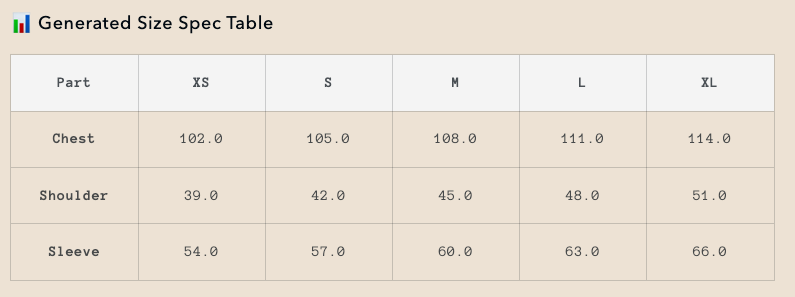
Size Chart Guide for Fashion Brands: Principles, Grading Logic, and How to Use Our Tool
Creating accurate and reliable size charts is essential for any fashion brand. Whether you're building a T-shirt brand, customizing dresses, or developing technical outerwear, the way your garments scale across sizes (XS to XL) affects fit, customer satisfaction, and production efficiency.
This guide outlines the data logic behind our Size Table Builder tool, including grading methodologies, real-world size chart references, and step-by-step usage instructions.
What Is a Size Chart and Why It Matters
A size chart is a structured table showing key body or garment measurements (e.g., chest, waist, shoulder) across different sizes (XS, S, M, L, XL). Brands use size charts for:
- Ensuring consistent fit across designs
- Communicating technical specs to manufacturers
- Reducing return rates in e-commerce
- Serving as reference for customer purchase decisions
A well-crafted size chart is the foundation of scalable and sustainable apparel production.
H2: Understanding Grading Logic
Grading refers to the system of adding or subtracting specific measurements between sizes. For example, increasing chest width by 4 cm per size from M to L.
Our tool uses grading steps across 5 sizes: XS, S, M, L, XL. Each product category has its own unique sizing logic due to differences in silhouette, ease, and structure. Below are the default presets used in our tool.

H3: Men's Product Grading Reference
| Product Type | Body Parts | Base (M size) | Grading Steps |
|---|---|---|---|
| T-shirt | Chest, Shoulder, Length | 100, 42, 70 | -8, -4, 0, +4, +6 |
| Shirt | Chest, Shoulder, Sleeve, Length | 104, 43, 62, 74 | -8, -4, 0, +4, +6 |
| Hoodie | Chest, Shoulder, Length | 110, 46, 72 | -10, -5, 0, +5, +8 |
| Pants | Waist, Hip, Outseam | 82, 100, 102 | -6, -3, 0, +3, +5 |
| Jacket | Chest, Shoulder, Sleeve, Length | 110, 46, 62, 72 | -10, -5, 0, +5, +7 |
H3: Women's Product Grading Reference
| Product Type | Body Parts | Base (M size) | Grading Steps |
|---|---|---|---|
| Dress | Bust, Waist, Hip, Length | 88, 70, 90, 90 | -6, -3, 0, +3, +6 |
| Blouse | Bust, Shoulder, Length | 86, 38, 60 | -5, -2.5, 0, +2.5, +4 |
| Skirt | Waist, Hip, Length | 66, 88, 60 | -6, -3, 0, +3, +6 |
| Pants | Waist, Hip, Outseam | 68, 90, 98 | -6, -3, 0, +3, +6 |
| Coat | Bust, Shoulder, Sleeve, Length | 94, 39, 60, 100 | -8, -4, 0, +4, +6 |
These grading values are derived from public size charts of Uniqlo, COS, Zara, and boutique design brands, and optimized for garment production feasibility.
How to Use the Size Table Builder Tool
Our Size Table Builder lets you generate custom size spec tables quickly. You can:
- Choose Product Category (e.g., Men's T-shirt)
- Auto-fill Body Parts and Base Size from preset templates
- Edit or Input Your Own Base Values (e.g., 100, 42, 70)
- Input Grading Steps (e.g., -8, -4, 0, +4, +6)
- Click Generate Table to view all size specs (XS to XL)
- Download as PDF for factory communication or team collaboration
Linking to Related Tools
To optimize your workflow, this tool links directly to:
Together, they help you build production-ready packs with accurate cost, size, and pricing logic.
Final Thoughts
Whether you're launching a DTC T-shirt brand or scaling a women's dress collection, having precise size charts is essential. This tool saves time, increases fit consistency, and improves your factory communication. Start building your size tables now to streamline development and reduce costly revisions.
